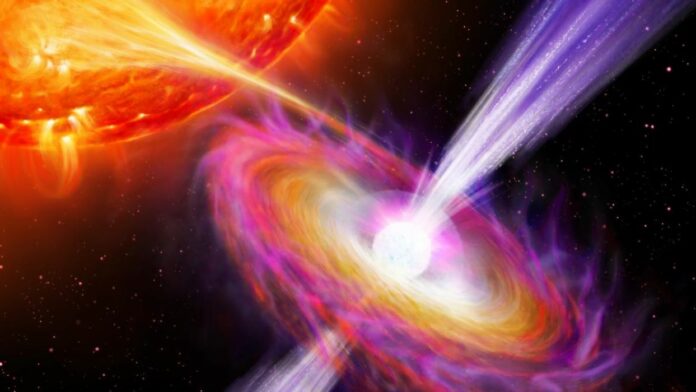Around the Universe, accreting and cataclysmic events produce relativistic jets, which majorly impact their surroundings. But the exact mechanism that fires these jets is still a mystery. When neutron stars are accreting, the speed of their compact jets may reveal whether the magnetic fields driving the accretion flow or the neutron star itself are supplying the energy. Unfortunately, no such measurements have been taken up until this point.
Type-I X-ray bursts, which are bright surface explosions caused by unstable thermonuclear burning of newly accreted material, are frequently seen in these objects. Usually, a rise in the mass-accretion rate onto the neutron star corresponds with these bursts.
In a new study, Astronomers, including those at the University of Warwick, report the observation of jets of matter being expelled into space at more than one-third the speed of light. This is the first time they have measured the speed of fast-moving jets in space.
Their approach could benefit star formation and the distribution of elements needed for life.
It was discovered that the matter jets released by stars, known as “cosmic cannibals,” traveled at a speed greater than one-third of the speed of light.
Co-Author Jakob van den Eijnden, Warwick Prize Fellow at the Department of Physics, University of Warwick, said: “The explosions occurred on neutron stars, which are incredibly dense and notorious for the enormous gravitational pull that makes them swallow gas from their surroundings – a gravitational pull that is only surpassed by black holes.“
“The material, mostly hydrogen from a nearby star that orbits around, swirls towards the collapsed star, falling like snow across its surface. As more and more material rains down, the gravitational field compresses it until a runaway nuclear explosion is initiated. This explosion impacts the jets, which shoot from the infalling material and eject particles into space at very high speed.”
To measure the speed and properties, the team compared to X-ray and radio signals picked up by the Australia Telescope Compact Array and ESA’s Integral satellite, which gave them a perfect experiment.
They found that the jets traveled around 114,000 kilometers per second, an incredible 35-40% of the speed of light. Co-author Thomas Russell, National Institute for Astrophysics, INAF, Palermo, Italy, said, “We had a very bri if short-lived impulse of extra material that’s shot into the jet and that we can track as it moves down the jet to learn about its speed.”
Jakob van den Eijnden added: “These explosions occur every couple of hours, but you can’t predict exactly when they will happen. So you must stare at the telescope observations for a long time and hope you catch a few bursts. Over three days of observations, we saw ten explosions and jets lighting up.”
Co-Author Nathalie Degenaar, University of Amsterdam, the Netherlands, continued: “Based on previous data, we thought the explosion would destroy the location where the jet was being launched. But we saw the opposite: a strong input into the jet rather than a disruption.”
Astronomers believe that the mass and rotation of neutron stars and black holes also impact the jets. They also believe the study will form the blueprint for future experiments into neutron stars and their jets.
Journal Reference:
- Russell, T.D., Degenaar, N., van den Eijnden, J. et al. Thermonuclear explosions on neutron stars reveal the speed of their jets. Nature 627, 763–766 (2024). DOI: 10.1038/s41586-024-07133-5
